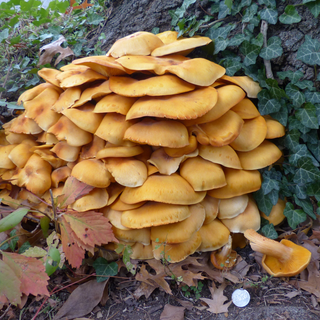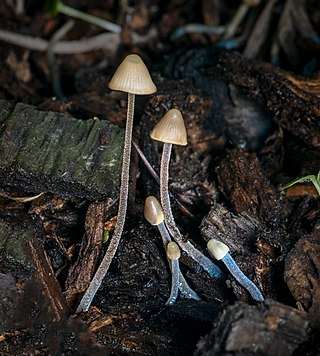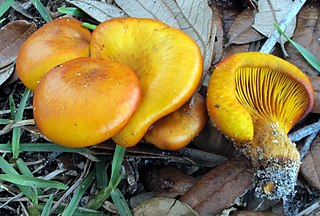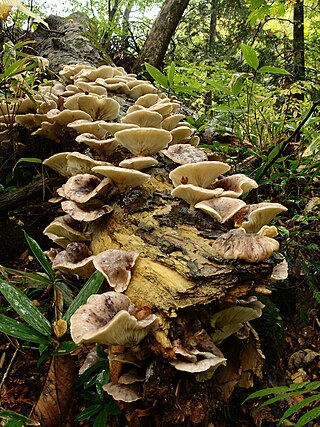
The Great Otway National Park is a national park located in the Barwon South West region of Victoria, Australia. The 103,185-hectare (254,980-acre) national park is situated approximately 162 kilometres (101 mi) southwest of Melbourne, in the Otway Ranges, a low coastal mountain range. It contains a diverse range of landscapes and vegetation types.

Omphalotus olearius, commonly known as the jack-o'-lantern mushroom, is a poisonous orange gilled mushroom that to an untrained eye appears similar to some chanterelles. It is notable for its bioluminescent properties. It is found in woodland areas in Europe, where it grows on decaying stumps, on buried roots or at the base of hardwood trees. It has also been reported from the Western Cape Province, South Africa. A similar, but phylogenetically distinct species found in eastern North America is Omphalotus illudens.

Luciferin is a generic term for the light-emitting compound found in organisms that generate bioluminescence. Luciferins typically undergo an enzyme-catalyzed reaction with molecular oxygen. The resulting transformation, which usually involves breaking off a molecular fragment, produces an excited state intermediate that emits light upon decaying to its ground state. The term may refer to molecules that are substrates for both luciferases and photoproteins.

Omphalotus illudens, commonly known as the eastern jack-o'lantern mushroom, is a large, orange mushroom that is often found in clumps on decaying stumps, buried roots, or at the base of hardwood trees in eastern North America. Its gills often exhibit a weak green bioluminescence when fresh. This green glow has been mentioned in several journal articles, which state that the phenomenon can persist up to 40–50 hours after the mushroom has been picked. It is believed that this display serves to attract insects to the mushroom's gills during nighttime, which can then distribute its spores across a wider area.

Foxfire, also called fairy fire and chimpanzee fire, is the bioluminescence created by some species of fungi present in decaying wood. The bluish-green glow is attributed to a luciferase, an oxidative enzyme, which emits light as it reacts with a luciferin. The phenomenon has been known since ancient times, with its source determined in 1823.

Pleurotus is a genus of gilled mushrooms which includes one of the most widely eaten mushrooms, P. ostreatus. Species of Pleurotus may be called oyster, abalone, or tree mushrooms, and are some of the most commonly cultivated edible mushrooms in the world. Pleurotus fungi have also been used in mycoremediation of pollutants, such as petroleum and polycyclic aromatic hydrocarbons.

Mycena is a large genus of small saprotrophic mushrooms that are rarely more than a few centimeters in width. The name Mycena comes from the Ancient Greek μύκηςmykes, meaning "fungus". Species in the genus Mycena are commonly known as bonnets.

Omphalotus is a genus of basidiomycete mushroom, in the family Omphalotaceae, formally circumscribed by Victor Fayod in 1889. Members have the traditional cap and stem structure. They are saprobic, and fruit in clumps on the ground, adjacent to host trees. The best known and type species is the jack-o'-lantern mushroom (Omphalotus olearius). Species of Omphalotus have been mistaken for chanterelles. All Omphalotus species are presumed poisonous, causing gastrointestinal symptoms. Some Omphalotus species have bioluminescent properties.

Omphalotus nidiformis, or ghost fungus, is a gilled basidiomycete mushroom most notable for its bioluminescent properties. It is known to be found primarily in southern Australia and Tasmania, but was reported from India in 2012 and 2018. The fan or funnel shaped fruit bodies are up to 30 cm (12 in) across, with cream-coloured caps overlain with shades of orange, brown, purple, or bluish-black. The white or cream gills run down the length of the stipe, which is up to 8 cm (3 in) long and tapers in thickness to the base. The fungus is both saprotrophic and parasitic, and its fruit bodies are generally found growing in overlapping clusters on a wide variety of dead or dying trees.

Orson Knapp Miller Jr. was an American mycologist. He published numerous papers in mycology and was responsible for the naming of many taxa, as well as being one of the authors erecting the genus Chroogomphus. He described Omphalotus olivascens, several species of Amanita, and the ghoul fungus Hebeloma aminophilum.

Mycena polygramma, commonly known as the grooved bonnet, is a species of mushroom in the family Mycenaceae. The inedible fruit bodies are small, pale gray-brown mushrooms with broadly conical caps, pinkish gills. They are found in small troops on stumps and branches of deciduous and occasionally coniferous trees. The mushroom is found in Asia, Europe, and North America, where it is typically found on twigs or buried wood, carrying out its role in the forest ecosystem by decomposing organic matter, recycling nutrients, and forming humus in the soil. M. polygramma contains two uncommon hydroxy fatty acids and is also a bioluminescent fungus whose intensity of light emission follows a diurnal pattern.

Panellus stipticus, commonly known as the bitter oyster, the astringent panus, the luminescent panellus, or the stiptic fungus, is a species of fungus. It belongs in the family Mycenaceae, and the type species of the genus Panellus. A common and widely distributed species, it is found in Asia, Australia, Europe, and North America, where it grows in groups or dense overlapping clusters on the logs, stumps, and trunks of deciduous trees, especially beech, oak, and birch. During the development of the fruit bodies, the mushrooms start out as tiny white knobs, which, over a period of one to three months, develop into fan- or kidney-shaped caps that measure up to 3 cm (1.2 in) broad. The caps are orange-yellow to brownish, and attached to the decaying wood by short stubby stalks that are connected off-center or on the side of the caps. The fungus was given its current scientific name in 1879, but has been known by many names since French mycologist Jean Bulliard first described it as Agaricus stypticus in 1783. Molecular phylogenetic analysis revealed P. stipticus to have a close genetic relationship with members of the genus Mycena.

Omphalotus olivascens, commonly known as the western jack-o'-lantern mushroom, is an orange to brown-colored gilled poisonous mushroom endemic to the California Floristic Province. It is sometimes mistaken for chanterelles.
Neonothopanus gardneri, locally known as flor de coco, is a bioluminescent fungus native to Goiás, Piauí and Tocantins states in Brazil.

Omphalotus subilludens, commonly known as the Southern Jack O'lantern mushroom, is a basidiomycete fungi in the genus Omphalotus. It has been definitively recorded in Florida and Texas with reports of species in Arizona and Mexico. It fruits on dead and dying trees during warmer parts of the year, producing a fairly large orange to brown-orange fruiting body that occurs in clusters. It is most closely related to O. olivascans, O. olearius, and O. japonicus and has high cross compatibility with O. olivescans and O. olearis. It is poisonous to humans and animals when eaten but rarely produces life-threatening symptoms, usually poisonings are resolved in 24-48 hours, with the majority of symptoms being gastrointestinal. Compounds in these mushrooms have pharmacological potential with potential applications in anti-coagulants, cancer therapies, and antibiotics. It is also bioluminescent producing a faint glow around the gills through the oxidation of luciferase.
Gerronema viridilucens is a species of agaric fungus in the family Marasmiaceae. Found in South America, the mycelium and fruit bodies of the fungus are bioluminescent.

Omphalotus japonicus, commonly known as the tsukiyotake(月夜茸), is an orange to brown-colored gilled mushroom native to Japan and Eastern Asia. It is a member of the cosmopolitan genus Omphalotus, the members of which have bioluminescent fruit bodies which glow in darkness. A 2004 molecular study shows it to be most closely related to a clade composed of Omphalotus nidiformis of Australia, Omphalotus olivascens of Western North America and Omphalotus olearius of Europe.

Hedleyella falconeri, the giant panda snail, is a species of air-breathing land snail, a terrestrial pulmonate gastropod mollusc in the family Caryodidae. It is the largest species of land snail to be found in Australia.
Omphalotus flagelliformis is a bioluminescent fungus native to Yunnan Province in southwestern China. Fruitbodies are reddish-brown to brown, with convex, flattened, or funnel-shaped caps typically 4–8 cm (1.6–3.1 in) in diameter. Described as new to science in 2013, the type collection was found the year previous in Kunming Botanical Garden at an elevation of 1,980 metres (6,500 ft). It was fruiting in a cluster around the base of a tree identified as being in the family Fagaceae. Molecular analysis suggests that Omphalotus flagelliformis is closely related to O. illudens and O. mexicanus. The specific epithet flagelliformis refers to the "flagelliform" appendages of the cheilocystidia.















